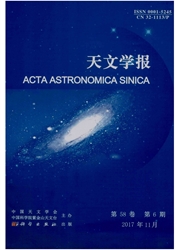

 中文摘要:
中文摘要:
利用赫歇尔空间望远镜的H—ATLAS(Herschel Astrophyrsical Terahertz Large Area Survey)SDP(ScienceDemonstrationPhase)天区从紫外到亚毫米波段数据,结合星族合成方法和尘埃模型,计算了星系的红外总光度.在此基础上,分别针对强恒星形成星系和弱恒星形成星系,研究了利用紫外光度、红外光度和Ha谱线计算得到的恒星形成率(StarFormationRate,SFR)的差异以及导致差异的内在物理起因.发现对于恒星形成活动强的星系,这3种恒星形成率指针给出的结果基本一致,弥散较小.只是在高恒星形成率端,利用紫外光度算得的恒星形成率比利用Ha谱线流量算得的恒星形成率略微偏小;而在低恒星形成率端,紫外光度指针偏大于Ha谱线指针;红外光度指针与Ha谱线指针在两端无明显偏差.对弱恒星形成星系,紫外光度、Ha谱线和红外光度3种恒星形成率指针存在明显的差异,且弥散较大.利用紫外光度和Ha谱线计算得到的恒星形成率的弥散和系统偏差随着星系年龄、质量的增加而增大.系统偏差增大的主要原因是利用紫外连续谱斜率β定标恒星形成活动较弱星系的消光时,高估了这些星系的紫外消光,使得消光改正后的紫外光度偏大.另外,MPA/JHU(Max Planck Institute for Astrophysies/Johns Hopkins University)数据库中弱恒星形成星系的恒星形成率SFR(Ha)比真实值偏低.
 英文摘要:
英文摘要:
With the multi-wavelength data from GALEX (Galaxy Evolution Explorer), SDSS (Sloan Digital Sky Survey), UKIDSS (UKIRT Infrared Deep Sky Survey), and Her- schel Astrophysical Terahertz Large Area Survey Science Demonstration Phase (H-ATLAS SDP), we have studied the star formation rate (SFR) indicators based on UV, Ha, and FIR, and found that the discrepancies among SFR estimates made by using different indi- cators are strongly correlated with star formation activities of galaxies. For those strong star forming galaxies (SSFGs), after correcting the dust attenuation and aperture effects, the SFR estimates from Ha agree with those from UV and infrared very well, only with a small scatter. For the low star forming galaxies (LSFGs), the difference between UV and Ha SFR indicators tends to increase with the age and stellar mass of galaxies. We have analyzed the reasons for those differences, and found that the recipe commonly applied to local starburst galaxies overestimates the dust attenuation of LSFGs, and then overestimates SFR(UV); and the SFR(Hc~) for LSFGs was underestimated in the Max Planck Institute for Astrophysics/Johns Hopkins University catalog.
 同期刊论文项目
同期刊论文项目
 同项目期刊论文
同项目期刊论文
 期刊信息
期刊信息
